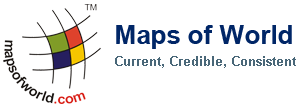Quick Facts
Area17,840,000sq. km
Countries12
Largest CountryBrazil
Smallest CountrySuriname
Highest PeakAconcagua, Argentina (22,830 feet above sea level)
Lowest PointLaguna del Caron, Argentina (344.5 feet below sea level)
Population387,489,196 (2011)
Major ReligionsRoman Catholicism, Protestant Christianity, Hinduism, Islam
Major LanguagesPortuguese, Spanish, English, French, Dutch
Continent name: South America
Story behind the name: German cartographer Martin Waldseemüller named the new continent after the Italian explorer, Amerigo Vespucci’s first name.
An alternative theory was proposed that the name America is derived from Richard Amerike, a merchant from Bristol, England, who is believed to have financed John Cabot’s voyage of discovery to Newfoundland in 1497.
New World is one of the names used specifically for America and the region south of America was then called South America. The term originated in the late 15th century, when America had been recently discovered by European explorers.
Area: 6,890,000 square miles or 17.84 million km²
Population: Approximately 387.5 million (2011)
Location and Geography: South America occupies the southern portion of the landmass referred to as the New World.
- Its triangular shape gives it the shortest coastline, for its size, of any of the continents
- It is home to the world’s highest waterfall, Angel Falls in Venezuela; the largest river (by volume), the Amazon River the longest mountain range, the Andes (whose highest mountain is Aconcagua at 6,962 m [22,841 ft]); the driest place on earth, the Atacama Desert; the largest rainforest, the Amazon Rainforest; the highest capital city, La Paz, Bolivia; the highest commercially navigable lake in the world, Lake Titicaca
- Brazil is, by far, the largest country in South America, encompassing around half of the continent’s land area and population. The remaining countries and territories are divided among three regions: The Andean States, the Guianas and the Southern Cone.
- South America is home to many interesting and unique species of animals including the llama, anaconda, piranha, jaguar, vicuña, and tapir
Economy and Currencies: South America is experiencing great economic development, with Venezuela, Colombia, Argentina, Uruguay and Peru growing their economies by over 8% per annum, but at the same time, they are experiencing very high inflation rates, like around 22% in Venezuela
South American countries and their currency:
- Argentina – Argentine peso (ARS)
- Bolivia – Bolivian boliviano (BOB)
- Brazil – Brazilian real (BRL)
- Chile – Chilean peso (CLP)
- Colombia – Colombian peso (COP)
- Ecuador – U.S. dollar (USD)
- French Guiana – Euro (EUR)
- Guyana – Guyanese dollar (GYD)
- Paraguay – Paraguayan guaraní (PYG)
- Peru – Peruvian nuevo sol (PEN)
- Suriname – Surinamese dollar (SRD)
- Uruguay – Uruguayan peso (UYU)
- Venezuela – Venezuelan bolívar fuerte (VEF)
Languages: Portuguese and Spanish are the most spoken languages in South America. Spanish is the official language of most countries, along with other native languages in some countries.
- Portuguese is spoken in Brazil
- Dutch is the official language of Suriname
- English is the official language of Guyana and is also spoken in the Falkland Islands
- French is the official language of French Guiana and the second language in Amapa (Brazil)
History and Colonization:
South America’s history is filled with tales of mystery and wealth, many originating from the Inca, the Maya, and the Aztec civilizations. These three great civilizations were the first empires in South America.
The Mayan civilization developed about 600 years ago in South America. The civilization lasted for about one thousand years until gradually they disappeared. The Inca lived high up in the Andes Mountains. They built cities of stone and they had terraced fields for growing crops. Unfortunately the Inca began to fight too many wars and before long, they disappeared as mysteriously as the Mayans.
The Aztecs were one of the most powerful civilizations. They had a mighty capital called Tenochtitlan. The Aztecs were very powerful until 1519, when a Spaniard named Hernando Cortez appeared. He was the leader of a small Spanish army. The Spanish declared war on the Aztecs, but the Aztecs were easily defeated because the Spanish had much better weapons and an experienced army. Soon the Aztecs also began to lose their power.
After the natives of South America lost most of their control, South America was primarily dominated by the Spanish. The Spanish colonized South America in hopes of finding gold and other valuable natural resources. It was initiated by the Spanish conquistadors and developed by the Monarchy of Spain through its administrators and missionaries. The motivations for colonial expansion were trade and the spread of the Christian faith through indigenous conversions. It lasted for over four hundred years, from 1492 to 1898.
Countries with their Capitals
- Argentina -Buenos Aires
- Bolivia – La Paz – seat of government; Sucre – legal capital and seat of judiciary
- Brazil – Brasilia
- Chile – Santiago
- Colombia – Bogotá
- Ecuador – Quito
- Falkland Islands / Islas Malvinas -Stanley
- French Guiana – Cayenne
- Guyana – Georgetown
- Paraguay – Asunción
- Peru – Lima
- Suriname – Paramaribo
- Uruguay – Montevideo
- Venezuela – Caracas
Music
South American nations have a rich variety of music. Some of the most famous genres include samba from Brazil, tango from Argentina & Uruguay, and cumbia from Colombia.
Major religions: Roman Catholicism, Protestantism
ACOD~20120924
Last Updated on: May 30th, 2018


